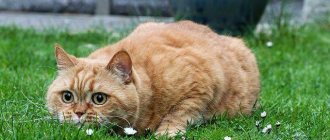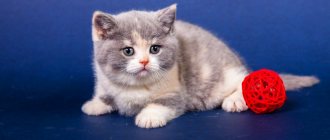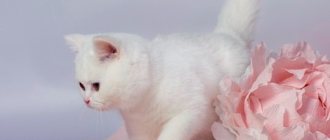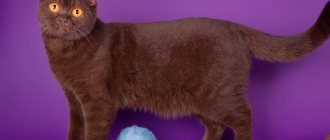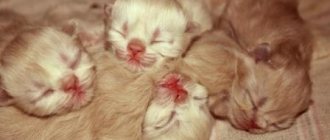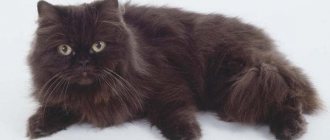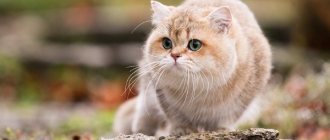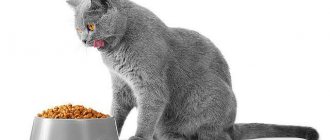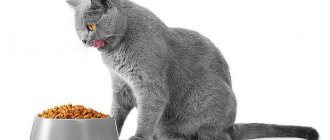BRITISH TABBY: COLOR STANDARD
British tabbies, regardless of the pattern on the coat, must have the following elements in their color (the exception is the ticked color - it has no pattern):
- the letter "M" on the forehead;
- “necklaces” on the chest;
- stripes on the paws;
- tail rings;
- one or two rows of spots on the belly;
- A contrasting tabby pattern is required;
- a light spot on each ear on the outside;
- eyeliner and nose to match the main color.
Photo: British spotted tabby cat, spotted chocolate color BRI b 24
British tabby color is based on a good contrast pattern; if it is blurred, it is rejected by experts. Most likely there was an incorrect mating, where one of the parents was a solid color and the other was a tabby.
The eye color of a British cat must correspond to the standard of the main color (most often golden, less often green or blue).
The Case of the Redheads
Spotted cat - examples of breeds and their names
However, there is an exception to this series. The fact is that the influence of the “non-agouti” allele on the “O” (“Orange”) gene is excluded. It is because of this that naturally occurring ginger cats (cream-colored) should have such an intriguing tabby coloring. Meanwhile, the “solid” cream color (very wide, differently colored stripes, as if identical to the human eye) is the result of long-term work by breeding specialists.
Important! All "furry enigmas" potentially have tabby coloring in their genetic "menu". Evidence of this is the residual effect in many kittens (“ghost”, baby tabby). However, after molting, it becomes uniformly colored throughout its entire body. Consequently, not all cats exhibit genotype “A” (agouti), which is what leads to the desired effect.
BRITISH SHORTHAIR TABBY CAT: VARIETIES OF COLOR PATTERNS
Shorthair British tabby cat, may be one of the following color subspecies:
- ticked;
- spotted (leopard);
- striped (brindle);
- marble.
Let's look at all types of colors schematically.
Where does the British marbled cat come from?
Since the beginning of the 20th century.
British cats included not only plain blue animals, but also tabby cats with different shades on their fur coats. Thus, in 1901, American felinologists registered a Belle cat with a red tabby color. British marbled cats appeared as a result of crossing with other breeds
The consequence of two world wars was the almost complete extermination of the British breed, so breeders began to crossbreed pets with representatives of other varieties - Burmese, Russian Blues, Persians and Scottish. The result was the appearance of many varieties of British color while simultaneously preserving the breed characteristics (wide paws, protruding cheekbones, “plush” coat).
At the same time, among all the variations of the striped coat of the British fur coat, it is the marble color that is considered classic, occurring naturally. Zoologists are inclined to believe that the symmetrical darkening on the fur of catfish from Foggy Albion is an inheritance from wild Asian or African ancestors.
TICKED BRITISH COLOR
The ticked color of the British cats is similar in appearance to the solid color, although it belongs to the Tibby color of British cats. The color should be even and only the upper part should look like “spraying”.
By spreading the fur, you can see that each hair has stripes. The undercoat corresponds to the color of the coat (chocolate, blue, lilac, etc.).
Of all the tabby markings in the ticked color of a British cat, only the letter “M” is present on the forehead and drawn curls on the cheeks. All other stripes, spots, rings on the tail and “necklaces” on the chest are rejected.
This color is very similar to the shaded and veiled one, only it has a higher intensity of the main color. Eyes are orange, golden or green.
Photo: golden ticked British tabby kitten BRI ny 25 64
Where did this color come from and why is it called that?
The question of where cats of such bizarre colors and different breeds come from will certainly arise if a British kitten appears in the house. The tabby color was most likely inherited by domestic cats from their wild ancestors, the Nubian Dun. It is from this species of cat that all our short-haired pets originated.
As for the term “tabby” itself, there are several versions about its origin. The most beautiful sounds like this. Somewhere at the beginning of the 17th century, silk fabrics, which were worth their weight in gold, were first brought to England. Their pattern was very similar to a cat's color and was called "tabbis". And when they later began to breed cats with a similar color, they were called tabby. In addition, cats of this color, like silk, were very expensive, since breeding them is extremely difficult - it is difficult to obtain the necessary pattern, shade and eye color that matches them.
SPOTTED TABBY, LEOPARD COLOR BRITISH
According to the standard, the spotted color of the British must contain the letter “M” on the forehead, “necklaces”, stripes on the paws, rings on the tail, spots on the belly, a contrasting pattern, eyeliner and nose.
The British spotted cat can also be called Spotted tabby or leopard, which, in principle, is the same thing. The color must invariably include: the letter “M” on the forehead, “necklaces”, stripes on the paws, rings on the tail, spots on the belly, a contrasting pattern, eyeliner and nose, all according to the standard. The spotted color is the most common of all tabby colors. The British spotted cat looks elegant and looks like a leopard, which is why it received this second name for the color. British spotted kittens can be born from parents of any tabby color. Eyes can be copper or green (green eye color is characteristic of golden and sometimes silver colors).
Photo of a British tabby kitten, black silver spotted color BRI ns 24
It is fundamentally
Tabby cat: examples of breeds and colors
It is necessary that among the key elements and characteristic features of this cat color the following must be present:
- the presence on the cat’s forehead of an improvised pattern resembling the human letter “M”. Experts also refer to this sign as the “sign of the scarab.” All tabby animals must have this feature;
- The cat's fur seems to be divided into two levels. The initial – bottom – layer creates the general background. The top layer just forms the famous pattern, which, thanks to the synergistic effect, has a peculiar depth;
- Fluffy's chest has a pattern with fancy necklaces;
- the cat's tail has certain "rings";
- the cat’s eyes and nose are emphasized with a certain color;
- Each ear of such an animal should have a light spot.
It is interesting that the distant ancestors who passed on such sophisticated colors to the living tabby cats lived in the wild in India, Africa and Kazakhstan.
BRITISH STRIPED COLOR (BRINCH, MACKERL)
The striped color of the British (British brindle tabby) must comply with all the same standards as the spotted one, only the pattern on the back and sides must have clear and uninterrupted stripes. In the color of a British Tabby Shorthair cat, the stripes should start at the spine and extend all the way to the paws. The stripes of a British brindle cat are narrow and frequent (and it is believed that the more often the better). Mackerel stripes (mackerel) should not intersect each other, be strictly vertical and always contrasting.
A brindle (striped) British kitten, even with very clear stripes, can “stretch” its color by adulthood and, if the stripes begin to be interrupted anywhere, the color is reviewed by experts and assigned - spotted. The full color of a British brindle kitten will be formed only by the age of one year (other tabby colors are not subject to such changes and most often do not change the appearance of the tabby pattern in adulthood).
British tabby cats are not as common as spotted cats, but more common than marbled cats.
The eye color of British tabby cats can be copper (golden, orange) or green (gold, occasionally silver).
Chocolate tabby British kitten: photo of California
Types of drawings
Felinologists (specialists in the breeding and selection of cats) distinguish 4 basic types of patterns inherent in the tabby color:
- ticked (Abyssinian);
- striped (mackerel);
- classic (marble);
- spotted (leopard).
Ticked
The most inconspicuous, barely distinguishable tabby color is ticked.
The color of the coat of such a pet is almost monochromatic. But, if you look closely, you may notice slightly visible stripes, small marks or small “freckles” that differ from the dominant background of the cat’s fur by a couple of tones. A pronounced, clear pattern is observed on the muzzle, chest, paws and tail of the animal.
The ticked color option is typical for Abyssinian cats. Hence the second name for this tabby color – Abyssinian.
Striped
If there are expressive narrow lines on the cat’s fur, then the color is considered striped, brindle (due to its resemblance to a tiger).
Vertical stripes are distributed parallel to each other, starting from the spine and going down to the stomach in many branches. The stripes stand out against the main background in a contrasting color.
Another name - mackerel - the pattern received due to its similarity with the coloring of mackerel - a striped fish.
Classical
The classic tabby color is considered the most beautiful.
The graphic patterns on the paws and neck of the animal are not very clearly expressed. The back and sides of the cat are decorated with interesting large spots, various curls and wide stripes.
Thanks to the contrasting color, intricate figures stand out well against the dominant tone ─ any tone other than white. This color is also known as “marble”.
Spotted
The spotted color type is defined by felinologists as leopard print. It is characterized by patterns that consist of specks and specks. A drawing of a relatively dominant color may be bright or not very different in tone from the base. An animal with this pattern looks like a small leopard.
Rarer variants
There are cats with rare tabby colors. Such colorings are an exception and do not fit into the main classification of tabby types:
- rosette: reminiscent of leopard print. Large spots with a dark outline look like irregular circles with a light center. The colors of the pattern contrast with the main background of the wool;
- tortoiseshell: characterized by the presence of two colors in the color of the animal (mainly yellow and black shades). The spots are not very bright, located in a chaotic manner;
- Calico: another basic tone is added - white. The pattern consists of short stripes and spots located on the pet’s paws, neck, muzzle and tail. The Calico tabby color is also called "spotted and white";
- patched: unusual coloring combines tortoiseshell and calico. A fairly large pattern of spots of different colors resembles patches;
- Links point: the pattern covers only some parts of the body (ears, muzzle, limbs, tail, chest or spine area). The body of a pet with a lynx point color is one color.
Tabby calico kitten
BRITISH MARBLE COLOR (MARBLE)
The British merle color is a very bright, beautiful color, perhaps the most complex in the tabby series. Marbled British cats wear beautiful patterns on their backs (2 stripes along the ridge, closed large circles on the sides, inside of which there is a clear large painted spot. And this entire pattern should not intersect or be interrupted. Also, a British marbled tabby cat has a butterfly pattern on the back of its head, patterns on the cheeks, starting from the corners of the eyes, on the forehead the letter "M". In addition, the British marble cat has closed "necklaces" on the chest (the larger the better), clear rings on the paws and tail. The British marble cat is very valued among breeders for its beautiful design, especially if the color is drawn correctly.
A British merle color may not be contrasting, in which case the color is rejected.
Photo: British cat Emili black marble on gold BRI ny 22 64
The character of the British marbled cat is no different from all other colors, although often future owners are interested in it, thinking that it is a separate breed of cat.
The marbled color of British kittens is visible from birth and is already quite contrasting. The necessary stripes, circles, and rings are clearly visible. The pattern of a British marbled kitten (British marbled kitten) may blend in a little with the main color of the coat, do not worry, most often by 2 months everything evens out and the color becomes most expressive.
Genetic properties and anti-properties
It is this gene that has such a valuable property of brightening up any hair of a cat’s fur in a special way, alternately alternating transverse stripes of different colors (dark, light). If in dark areas there is a significant concentration of a pigment called eumelanin, then in light stripes there is much less of it. The spherical granules of this version of melanin, which reflects light waves in the yellow-orange range, have the peculiarity of elongating and taking on the shape of an ellipse, located along the entire length of the hair. Which causes the desired effect, as a result of which a tabby cat appears.
Tabby cat breed (Siberian)
If the cat’s genotype contains the so-called “homozygous” allele (“non-agouti”), then the tabby coloring does not appear. The allele suppresses and masks tabby genes. As a result, the color of the cat's fur turns out to be completely the same (epistasis).
BRITISH TABBY CATS: TYPES OF COLOR
In British tabby cats, the main tone - the color of the coat - is light (for example, red, chocolate, lilac, etc.), but the pattern is made in a dark color (black, blue, red). The colors of British tabby cats (or tabby/tabby) are encoded with the numbers 22/23/24/25, which are added after the main color color.
British tabbies can be of the following types:
- black ticked/spotted/striped/marbled BRI n 25/24/23/22 (BROWN TABBY);
- blue ticked/spotted/striped/marbled BRI a 25/24/23/22 BLUE TABBY;
- lilac ticked/spotted/striped/marbled BRI c 25/24/23/22 LILAC TABBY;
- chocolate ticked/spotted/striped/marbled BRI b 25/24/23/22 CHOCOLATE TABBY;
- cinnamon ticked/spotted/striped/marbled BRI o 25/24/23/22 CINNAMON TABBY;
- fawn ticked/spotted/striped/marbled BRI p 25/24/23/22 FAVN TABBY;
- red ticked/spotted/striped/marbled BRI d 25/24/23/22 RED TABBY;
- cream ticked/spotted/striped/marbled BRI e 25/24/23/22 CREAM TABBY;
- silver ticked/spotted/striped/marbled BRI s 25/24/23/22 – SILVER TABBY;
- golden ticked/spotted/striped/marbled BRI y 25/24/23/22 GOLDEN TABBY;
- tortoiseshell ticked/spotted/striped/marbled BRI 25/24/23/22;
- bicolor ticked/spotted/striped/marbled BRI 25/24/23/22;
- color-point ticked/spotted/striped/marbled BRI 25/24/23/22.
GENETICS OF COLOR
The tabby pattern is due to the A gene - agotti.
You can often hear the phrase from. What does it mean? — Genetically, all cats (yes, all cats, of all breeds and species) have a pattern on their body, but the magic gene “not agouti” hides the pattern on the body.
Color formula:
AA - a tabby cat (with a pattern), she will always give birth to kittens with a pattern, regardless of the color of the second sire;
Aa is a tabby cat (with a pattern), she will always give birth to kittens with and without a pattern (plain);
aa is a cat of a single color (without a pattern).
WHAT DOES A TABBY CAT'S HAIR LOOK LIKE?
The tip of the hair is well pigmented, then there is a less saturated section of the hair and so alternates.
There are several types of tabby patterns - brindle, spotted, ticked, marbled.
- Ta – ticked tabby
- T – striped/spotted tabby
- tb – marbled tabby
Color dominance:
- Ta is dominant over T and tb colors
- T is dominant over tb color
- tb - recessive color
INTERESTING TO KNOW
- Most kittens have a visible tabby pattern at birth, even if they are born to solid-colored parents. This confirms that all cats are tabbies.
- If we breed a cat with the recessive allele “aa” (it has an even, solid color) with a tabby cat who has the “Aa” gene, we will get offspring with a tabby pattern and a solid color.
- Two same-colored parents can never produce a tabby kitten.
- From two tabby sires a monochromatic kitten can be born (in the case when the formula of the parents is Aa + Aa - this means that they are carriers of a monochromatic color, being drawn)
- Two ticked parents can produce kittens: ticked, spotted/striped and marbled
- Two spotted/striped parents can produce kittens: spotted/striped and marbled
- Only merle kittens can be born from two merle parents and never spotted/striped or ticked kittens.
Possible tabby colors
It should be noted that tabby is precisely the pattern on the animal’s fur. The main background against which these patterns stand out can be completely varied. The color of the cat's nose and paw pads corresponds to the basic tone.
There are several common tabbed colors.
Brown
A cat with a brown tabby color has patterns on his coat that are covered with completely black hair - it resembles the color of coal soot. And the main color of the coat is copper-brown.
The animal's nose has a red tint and is outlined. The pet's tail is covered with spots in the form of rings - this is generally a distinctive feature of the tabby color.
Lilac
On a light lavender background there are gray spots, as if dusted with frost: this is a lilac tabby. The iris of his eyes is yellow or orange. This color is quite rare.
The lilac Briton can boast of such an exotic coat.
Silver
On a light gray background there is a black pattern of curls, stripes and spots: this is a silver tabby color. There are variants of red-silver colors: on a silver-cream tone there is a reddish pattern.
Silver cat
Red
Red tabby is also called marmalade color. It is characterized by pronounced red markings on a lighter red background. The eyes of such a cat are orange, copper, yellow, brown with a dark red outline.
brindle
The brindle color of the tabby brings the cat closer in appearance to a real predator from the cat family - the tiger. Pronounced stripes are clearly colored, usually their color contrasts with the main background.
Blue
The main background of this color is delicate beige. On it are figures of blue or gray shades. At the same time, the eyes are yellow-orange tones with blue eyeliner.
Marble
Very beautiful color. So called because the shape of the stains and patterns resembles the pattern on marble. The spots are large, well-defined, do not merge or connect with each other.
Cream
Spots and stripes of peach or sand color on a mostly pale cream background are a characteristic feature of the cream tabby color. The eyes are outlined with a dark pink stripe.
Chocolate
The pattern is characterized by a rich chocolate color on a light milky coffee background. The iris of the eyes with this color is yellow or brown. The nose is dark brown or brick red.
Other color options
| Color name | Color of stripes and spots | Dominant shade |
| Amber | Black smoky | Peach |
| Bronze | Chocolate dark | Warm creamy |
| Chestnut | Brown bright | Cream or orange |
| Golden | Black | Light milk chocolate |
| Cinnamon color | Chocolate light with red tints | 2-3 tones lighter than the pattern |
Genetics of color
In the genetic code, absolutely all cats have the T (tabby) gene, which means that initially they are all tabbies.
But the pattern on the animal’s skin is not always observed. There is another gene, agouti (A), which affects the color of cats and the appearance of patterns on the animal’s coat. The amazing agouti gene colors each hair in different shades. The colors alternate in the form of transverse dark and light stripes.
When agouti is dominant (AA), the hairs in the dark areas are denser in color. There is less coloring pigment in the lighter areas. A tabby pattern appears with a noticeable color contrast.
If the gene is recessive (aa), the animal’s coat is monochromatic. In this case, the pigment granules are distributed evenly and color the hair equally along the entire length. It turns out that agouti does not affect the pigmentation itself, but is responsible for the distribution of colors on each individual hair.
Another gene, melanin, is responsible for the color of the pigment. It is the amount of this substance that determines the color of the animal’s eyes, skin and fur.
BRITISH - TABBY COLOR: SPOTTED, BRIDGE (STRIPPED), MARBLE
Here are photos of British cats, cats, tabby kittens. British tabbies are spotted, striped (brindle), marbled.
| British tabby, photo of chocolate silver ticked British kitten BRI bs 25 | Photo of a British tabby kitten: lilac ticked BRI c | British tabby cat, photo of golden ticked Briton BRI ny 25 |
| Photos of British tabby kittens: red ticked color BRI d 25 | British tabby cat, photo of red silver color BRI ds 25 | British cat tabby color, photo of cream silver ticked color BRI es 25 |
British spotted cat cinnamon BRI o 24 | British brindle kitten, photo red British BRI d 23 | British brindle (striped) tabby cat, photo of a chocolate tabby British kitten BRI b 23 |
| British tabby (tiger) cat, photo of black silver British tabby BRI ns 23 | British spotted cat, photo of blue spotted tabby color BRI a 24 | British tabby, photo of lilac spotted British tabby kitten BRI c 24 |
| British tabby, photo of tortoiseshell spotted color BRI f 24 | British tabby cat, photo of chocolate spotted British kitten BRI b 24 | Leopard tabby color, photo of golden spotted British kitten BRI ny 24 |
British tabby, photo of tortoiseshell tabby color BRI q 23 | Marbled British kitten, photo of chocolate marbled British kitten BRI b 22 | British merle kitten, photo fawn harlequin color BRI p 22 |
Marbled British cat, photo cinnamon marbled color BRI o 22 | British tabby cat, photo cream tabby color BRI e 22 | British marble on silver, photo red marble British tabby BRI ds 22 |
British kitten, photo of marbled chocolate color BRI b 22 | British merle cat, photo lilac merle British tabby BRI c 22 | British merle kitten, photo of black golden merle BRI ny 22 64 |
British black marbled on silver, photo of tortoiseshell silver British kitten BRI fs 22 | British blue marble, photo of black blue marble British tabby kitten BRI a 22 | British merle cat on silver, photo of black merle British tabby color BRI ns 22 64 |
| Silver merle Briton, photo of British merle color on silver tabby BRI ns 22 | British tabby, photo color point tabby color BRI a 33 21 | British cat black marbled bicolor, photo of color black silver marbled bicolor tabby BRI ns 03 22 |
Color variety
The most popular among animals with similar colors are silver tabby and gray cats, which have markings of different tones. Smoky black and reddish, blue and chocolate, lilac color shades may be present here. Other tabby colors are also available. Among them are black silver tabby, amber, blue silver, cameo, caramel, chestnut and many others.
Important! It should be noted that this coloring largely depends on the existing pattern. Thus, the classic (marble) version of the pattern combines various dark stripes with a light base background of the “fur coat”. In the spotted version, the pattern plays with “warm” tones. The mackerel variant combines darkish stripes on a silver and gray base. In turn, with the ticked subtype, almost all colors possible in the cat world are found.
BRITISH TABBY KITTENS
British tabby kittens can only be born from parents of this color. Those. at least one parent must be a tabby (with a pattern). A British tabby/tabby kitten should have a fairly contrasting pattern from birth. It must be remembered that over time, the color of British tabby cats “erodes” as the kitten grows, so, for example, a brindle color can turn out to be a spotted color. The full tabby color of British cats is formed by one year.
| In our cattery you can “buy a real British kitten.” We have many different colors, we will help you choose and answer all your questions! |
Character of the Asian Tabby cat breed
Asian tabbies are intelligent and peaceful. Aggression is alien to them, but they are very active. They love communication and affection, and take part in games with pleasure. At the same time, cats will not insist on endless attention from the owner - they have enough intelligence and patience to wait until he finishes his business and can communicate with them. The distinctive character traits of this breed are restraint, self-esteem and excellent upbringing.
As children, Asian tabbies are very curious. Their energy is in full swing, they are ready to play until they drop. Therefore, it is necessary to look after kittens - the surprises they present may not always turn out to be pleasant. Looking for adventure is the main activity of these kittens, especially if they are bored or feel lonely.
When a tabby kitten is left alone at home, it is worth checking whether the windows are closed, as well as the doors to those rooms where the kitten is not allowed to enter, and whether there are breakable or valuable objects within the pet’s access. Otherwise, you can rest assured about the kitten - it will react calmly to separation from its owner.
Tabbie dogs show some wariness around strangers. At the same time, they are invariably “polite” in English. But household members equally bask in their love, since the Asian tabby treats each of them with great warmth, regardless of his age. But these cats have a special love for small children. They strive to surround them with almost maternal care and become very attached to them. But it is not difficult for the Asian tabby to find a common language with other family members.
This is not a weak-willed or helpless mug - a tabby will never allow himself to be offended, because he will easily put in his place anyone who crosses boundaries in communicating with her. At the same time, she will not start fights with other pets, will not bite or scratch the child, and will be careful and patient when playing with children. At the same time, the tabby will prefer to sit out the “storm” somewhere in a quiet corner.
Features of character and behavior
The British cat, massive and clumsy, is actually very, very active. It’s just that he prefers sleep to any active activity. The British sleep 20 hours a day, sometimes without stopping to eat.
Up to 3-4 years The British are not yet fully formed, both physically and psychologically. At this age, they are, in essence, still kittens with appropriate behavior - active and mischievous. Then the kitten becomes much calmer.
The breed is characterized by absolute self-sufficiency. The British Shorthair cat itself determines the rhythm of life, the time for affection and, especially, for games. Shows independence from early childhood. Even a small kitten has sacred knowledge of its rights. The most important thing is not to waste time. Kittens up to one year old are amenable to suggestion and education. After - no.
Soft and independent Britons have their own opinion about everyone. The kitten will choose a place to sleep himself. The owner’s task is to equip it. When dealing with a Briton, you must remember: he has remarkable intelligence and memory. Reviews indicate that from childhood the kitten demands respect for its person and really does not like noise.
You will have to forget about closed doors in the apartment: this will cause shock in an absolutely calm cat, even to the point of depression. Ideally, of course, the British should be able to roam freely. Then neither the cat nor the owner will experience any shocks.
The British Shorthair cat is non-aggressive, but will not allow itself to be offended. She is unobtrusive and rarely talks out loud about her feelings. If a Briton wants to eat, this will be expressed in a silent picket next to the cup.
Kittens get used to the family and are sincerely attached to the owner, but they can do quite well without his company.
Required elements
- The mark is actually having the same pattern. In this case, the hair of the mantle should be uniform in color to the base.
- On the forehead of such cats there should be a pattern resembling the letter so-called. scarab sign.
- There should be a fingerprint-shaped mark on the back of your ear.
- The nose and eyes should be outlined. The outline color should be the same as the main color.
- The drawing, if available, must contain the following elements: “necklace”; — three closed straps on the chest; “curls” on the cheeks; on the abdomen there are two rows of double spots. All patterns should be clear and rich, and the colors should be deep.
- The tabby cat also has a characteristic eye color: gold, orange and copper. If the coloring is silver, the cat's eyes should be green.
If the British has a fuzzy color, and the patterns are cloudy and merge with the main color, then this is a defect. Most likely, one of the parents was tabby and the other was ugly.

